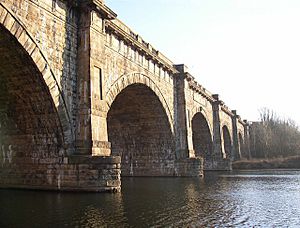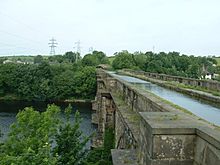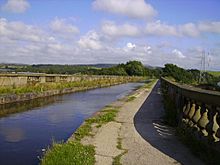Lune Aqueduct facts for kids
Quick facts for kids Lune Aqueduct |
|
|---|---|
 |
|
| Coordinates | 54°04′06″N 2°47′22″W / 54.06838°N 2.78932°W |
| OS grid reference | |
| Carries | Lancaster Canal |
| Crosses | River Lune |
| Locale | Lancaster |
| Maintained by | Canal & River Trust |
| Preceded by | A683 bridge |
| Followed by | Skerton Bridge |
| Characteristics | |
| Trough construction | Concrete |
| Pier construction | Stone |
| Total length | 664 ft (202.4 m) |
| Width | 20 ft (6.0 m) |
| Height | 61 ft (18.6m) |
| Traversable? | Yes |
| Towpaths | Both |
| Number of spans | 5 |
| History | |
| Designer | John Rennie |
| Construction begin | January 1794 |
| Opened | Autumn 1797 |
|
Listed Building – Grade I
|
|
| Official name: Lancaster Canal Lune Aqueduct | |
| Designated: | 22 December 1953 |
| Reference #: | 1362451 |
| Lua error in Module:Location_map at line 420: attempt to index field 'wikibase' (a nil value). | |
The Lune Aqueduct is an amazing bridge that carries the Lancaster Canal over the River Lune. It's located on the east side of Lancaster in Lancashire, England. This special bridge was finished in 1797 and cost nearly £50,000 to build. It's so important that it's a Grade I listed building, which means it's a very old and protected structure.
Contents
Building the Lune Aqueduct
The Lune Aqueduct was designed by a clever engineer named John Rennie. An architect called Alexander Stevens helped build it. The total cost of building this huge structure was about £50,000.
How the Aqueduct Was Built
The aqueduct is made from five strong stone arches. These arches hold up a stone channel that carries the canal water. To make the piers (the parts that stand in the water) extra strong, a special volcanic powder called pozzolana was brought in. This powder was mixed with cement, allowing the concrete to set even underwater!
Challenges During Construction
Building the aqueduct was a big challenge. They had to work very fast to finish the first parts before winter floods arrived. This meant working day and night. Because of this rush, the project ended up costing over £30,000 more than they first thought. This huge extra cost meant there wasn't enough money left to connect the Lancaster Canal to the main canal network. They had planned to build another aqueduct over the River Ribble, but it never happened.
Fixing Up the Aqueduct
In January 2011, work began to restore the Lune Aqueduct. This big project was finished in March 2012.
What Was Done During Restoration
The restoration work involved several important tasks:
- They fixed the canal channel where the water flows.
- They repaired the stone parts of the aqueduct.
- They cleaned off any graffiti.
- They made it easier for people to visit and enjoy the aqueduct.
Who Paid for the Repairs?
The restoration project cost £2.4 million. Many groups helped pay for it, including British Waterways, the Lancaster Canal Trust, English Heritage, and the Heritage Lottery Fund.
Messages on the Aqueduct
The Lune Aqueduct has two special messages carved into its stone.
- On the north side, it says: "To Public Prosperity." This means it was built to help everyone in the community.
- On the south side, there's a message in Latin. It says: "QUAE DEERANT ADEUNT: SOCIANTUR DISSITA: MERCES FLUMINA CONVENIUNT ARTE DATURA NOVAS. A.D. MDCCXCVII. ING. I. RENNIE EXTRUX. A. STEVENS. P. ET F."
Translation of the Latin Message
This long Latin message can be translated to mean: "Things that are missing are brought together. Things far apart are connected. Rivers themselves meet with the help of art, to bring new ways of trade. AD 1797. Engineer J Rennie. Built by A Stevens father and son."
Gallery



